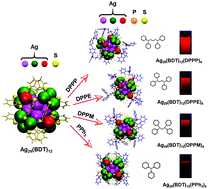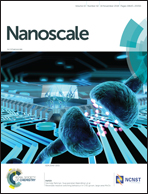A thirty-fold photoluminescence enhancement induced by secondary ligands in monolayer protected silver clusters†
Abstract
In this paper, we demonstrate that systematic replacement of the secondary ligand PPh3 leads to an enhancement in the near-infrared (NIR) photoluminescence (PL) of [Ag29(BDT)12(PPh3)4]3−. While the replacement of PPh3 with other monophosphines enhances luminescence slightly, the replacement with diphosphines of increasing chain length leads to a drastic PL enhancement, as high as 30 times compared to the parent cluster, [Ag29(BDT)12(PPh3)4]3−. Computational modeling suggests that the emission is a ligand to metal charge transfer (LMCT) which is affected by the nature of the secondary ligand. Control experiments with systematic replacement of the secondary ligand confirm its influence on the emission. The excited state dynamics shows this emission to be phosphorescent in nature which arises from the triplet excited state. This enhanced luminescence has been used to develop a prototypical O2 sensor. Moreover, a similar enhancement was also found for [Ag51(BDT)19(PPh3)3]3−. The work presents an easy approach to the PL enhancement of Ag clusters for various applications.



 Please wait while we load your content...
Please wait while we load your content...